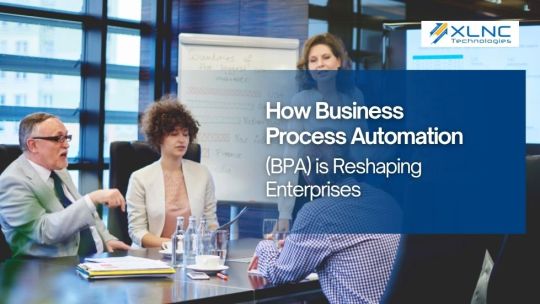#EnterpriseAutomation
Explore tagged Tumblr posts
Text
Eliminate Manual Workarounds—Talk to an SAP Expert
Why settle for short-term fixes when your business deserves long-term efficiency? If you're still relying on spreadsheets and manual workarounds, you're not alone—but you are at risk.
This video isn’t just a reflection of common operational gaps—it’s a wake-up call. In today's competitive environment, agility and data accuracy aren't optional. Businesses need integrated systems that provide real-time visibility, eliminate redundancies, and support smarter decisions at every level.
At Ikyam Solutions, we help businesses like yours transition from patchwork processes to intelligent, connected operations powered by SAP.
Let’s future-proof your business—starting today.
#BusinessEfficiency#DigitalTransformation#SAPSolutions#IkyamSolutions#SmartBusiness#EnterpriseAutomation#RealTimeData#IntegratedSystems#FutureReady#ManualToDigital#BusinessIntelligence#ProcessAutomation#OperationalExcellence#ScalableSolutions#DataDrivenDecisions
0 notes
Text
AWS Marketplace Expands with Agentic AI, Accelerating Enterprise Automation

Amazon Web Services (AWS) today unveiled a dedicated “Agentic AI” category in its AWS Marketplace, aiming to simplify and speed up enterprise adoption of advanced, autonomous AI systems. The move, announced at the AWS NYC Summit, marks a significant step toward making complex, workflow-driven AI agents—capable of reasoning, planning, and acting independently—as accessible and deployable as traditional cloud software.
The newly launched marketplace section features pre-built AI agents for industries like healthcare, finance, and IT, alongside tools and professional services from major partners including Anthropic, Automation Anywhere, Accenture, and IBM. Organizations can now discover, evaluate, and deploy these solutions directly within AWS’s cloud environment—reducing procurement time by up to 60%, according to company estimates.
AWS’s integration with Amazon Bedrock AgentCore enables enterprises to manage large-scale deployments securely, with features for memory, identity, and observability already baked in. The platform leverages AWS’s existing compliance and security infrastructure, addressing key concerns around data privacy and governance.
Industry partners have welcomed the announcement, positioning AWS Marketplace as a “growth engine” for AI innovation. Automation Anywhere and Adastra are among the first to offer specialized agents for financial analysis, content creation, and workflow automation. IBM and other consulting firms are also aligning their agentic solutions with AWS services to transform sectors like customer service and supply chain.
Early adopters, including AstraZeneca, Yahoo Finance, and Syngenta, report tangible gains in research speed and operational efficiency. AWS says its $100 million investment in the Generative AI Innovation Center will further accelerate agentic AI development, with upcoming features allowing deeper customization via Amazon Nova foundation models.
Swami Sivasubramanian, AWS VP for Agentic AI, described the launch as “a fundamental shift in how software is built, deployed, and interacts with the world.” With this move, AWS cements its role as a central hub for the next wave of enterprise AI—offering businesses of all sizes a fast, secure, and scalable on-ramp to autonomous, agent-driven automation.
#AI#AWS#AWSMarketplace#AgenticAI#EnterpriseAutomation#CloudComputing#AmazonWebServices#AIInnovation#AIAgents
0 notes
Text
How Business Process Automation (BPA) is Reshaping Enterprises

What is Business Process Automation (BPA)?
Business Process Automation (BPA) refers to using technology to perform business processes and workflows without human intervention. Unlike regular automation, BPA handles a mix of tasks from different business departments. From data processing automation to AI-powered workflow automation, BPA is helping businesses do more with less.
The Role of BPA in Modern Enterprises
As businesses accumulate huge amounts of information daily, automating business processes (BPA) becomes necessary. The global BPA market was estimated at $13 billion in 2024 and is expected to reach $23.9 billion by 2029 at a CAGR of 11.6%. Companies are using BPA software to gain better control over organizational workflows, improve the quality of decisions made, and automate processes to reduce human error. Enterprise process automation is most effective when performing monotonous tasks such as invoice processing, customer service, and compliance management. This allows employees to focus on more complex and detailed strategic tasks.
Key Benefits of Automating Business Processes
1. Increased efficiency and productivity.
Automation is one of the fastest and most efficient ways to augment productivity in any organization. An organization can complete its work without sacrificing time or accuracy by eliminating the number of people involved and automating the business process. Freeing employees from ancillary business processes enables them to concentrate more on essential, value-added tasks.
2. Cost Reduction
An organization can reduce its operational costs by using tools to automate business processes. In other words, automation makes it easier to reduce the amount of excessive manual work that goes into production costs.
3. Enhanced Accuracy and Compliance
Errors, risks, and other compliance issues are common with manual processes. The automatic processes enhance data quality, reducing errors in reports, invoices, and customer information.
4. Improved Customer Experience
Automating tedious business workflows improves efficiency within the organization, enabling businesses to get things done more quickly and improving service delivery. Intelligent analytics, self-service customer support, and chatbots help create a better customer experience.
5. Scalability and Agility
Agility is essential for scaling efficiently, especially for modern enterprises. Automating business processes helps in organizational flexibility for market demands and business growth.
Digital Process Automation vs. Traditional BPA
Traditional BPA
Sensors automatize mundane workflows.
Automation processes are based on rigid sets of rules.
Little integration is possible.
Digital Process Automation (DPA)
Digital Process Automation (DPA)
Incorporates AI, ML, and cloud computing for enhanced automation.
Easier for data-driven systems to make complex decisions.
Allow integration with new enterprise systems without restrictions.

How Enterprises Can Implement BPA Successfully
To prepare for effective automation of business processes, a company needs to do the following:
Spot Pain Points: Focus on operational workflows and review where there might be inefficiencies.
Choose the Right Technology: Approach business process automation software from a holistic organizational perspective.
Assure Integration: Select process automation tools that can be integrated without too much effort into the existing systems.
Evaluate and Adjust: Measure the outcomes constantly and refine the automation method.
Process Automation Services: Choosing the Right Partner
When deciding on a business process automation (BPA) service provider, it is critical to narrow down the options first. Some important points to take into account are:
Expertise in enterprise process automation.
Possibilities for scaling and a level of customization.
Issuance of security and compliance policies.
Integration of artificial intelligence and automation of processing.
Business Process Automation Examples Across Industries
Finance: Automated processes for data invoicing, fraud analysis, and risk evaluation.
Healthcare: Automating business processes for patient appointments, medical billing, and compliance supervision.
Retail: Automation tools based on AI for stock and customer intelligence gathering.
Manufacturing: Automation of production line processes by robotics and other processing aids.
HR Recruitment: Automation of recruitment, payroll, and staff induction business processes.
Overcoming Challenges in BPA Adoption
Despite the many advantages of business process automation, implementation issues persist.
Change Resistance: Employees can be concerned about redundant employment; this fear can be managed with proper education and training.
Integration Issues: The availability of suitable business process automation software is critical for these existing systems to interconnect with each other.
Security Risk: The implementation of the system must be done with the utmost care given to the data security laws.
Conclusion
The future of business process automation rests on AI, machine learning, and digital process automation (DPA) technologies. However, companies that successfully automate business processes, become more efficient and cost-effective, and improve customer experience will gain an advantage over competitors. With the right BPA services, companies can transform and stay responsive in a fast-paced business environment.
Are you thinking about enterprise transformation and automation? Contact XLNC Technologies today to take the first step toward automating and digitally transforming business processes.
Frequently Asked Questions
What is business process automation (BPA), and how does it work?
BPA refers to business process automation, which uses technologies to automate repetitive business processes, reducing the efforts, input, and location of manual work and the associated errors. Standardization, the use of AI software, and RPA (robotic process automation) make it possible to have automated explanations and parentheses in documents. These technologies also make it possible for activities to be more logically standardized and for business processes to make better decisions.
What are the key benefits of automating business processes?
Automation of business processes leads to efficiency as it eliminates manual work, reduces operating costs even further, improves accuracy and compliance, and gets better. It also improves customer experience, improves processes, and shortens response time.
How do enterprises choose the best business process automation software?
They evaluate the ease of integration with other systems, scalability, security, the possibility of AI implementation, and price. Additionally, dimension and vendor support are significant in the decision-making process.
Which industries benefit the most from process automation?
BPA greatly benefits various industries, like finance, healthcare, retail, manufacturing, and human resources. Finance automates billing processes and fraud detection; healthcare automates patient scheduling; retailers automate inventory control; supply chains for manufacturers get automated; and payroll and recruitment processes are automated in HR.
How does AI improve business process automation?
Artificial intelligence improves BPA through smart planning, management models, and automated natural language processing. Automating advanced predictive workflows enhances data accuracy, lowers the chance of human error, and improves productivity by allowing businesses to adapt to changing needs.
#BusinessProcessAutomation#BPA#AutomationSolutions#ProcessAutomation#DigitalAutomation#WorkflowAutomation#DigitalTransformation#EnterpriseAutomation#OperationalExcellence#EfficiencyDriven#ScalableSolutions
0 notes
Text
🛠️ Troubleshooting Ansible in Red Hat Enterprise Linux Automation
Ansible is widely used for IT automation, configuration management, and orchestration—especially in Red Hat Enterprise Linux (RHEL) environments. While it simplifies many tasks, troubleshooting can become necessary when things don’t go as planned.
In this blog, we’ll walk through how to approach and resolve common issues with Ansible in a Red Hat Automation environment—without diving into code.
✅ 1. Confirm Ansible Is Properly Installed
The first step is ensuring that Ansible is correctly set up on your system. Problems at this stage might include:
The tool not being recognized.
Incorrect versions or outdated installations.
Missing dependencies.
To address this:
Use Red Hat's official package repositories.
Ensure system updates and required packages are installed.
Check your subscription and access permissions through Red Hat Customer Portal.
🔍 2. Validate Your Inventory and Host Configuration
Many Ansible issues arise due to incorrect target machine details:
Mistyped hostnames or IP addresses.
Misconfigured inventory files.
Lack of connection between control and managed nodes.
It’s important to:
Review your host details.
Confirm network connectivity.
Verify authentication settings like SSH keys or passwords.
🔐 3. Address Access and Permissions Issues
Access problems can prevent Ansible from reaching and managing systems. This can happen if:
The user account lacks sufficient privileges.
The authentication method fails.
Firewalls or SELinux policies are blocking connections.
Make sure:
User roles and permissions are set appropriately.
Security configurations are reviewed.
Network routes are clear and accessible.
🛠️ 4. Analyze Playbook Execution Behavior
If a playbook is not performing as expected, the problem may be:
An error in the logic or structure of tasks.
Incorrect variable values.
Role or collection dependencies that aren’t met.
Tips for resolving these:
Walk through the playbook logic step-by-step.
Review variable definitions and naming consistency.
Ensure required roles or collections are present and up to date.
🏢 5. Review Automation Platform Components
When using Red Hat Ansible Automation Platform (e.g., Tower or Controller):
Check the job status and logs via the web interface.
Confirm that all services are running smoothly.
Look for alerts or system messages that indicate failures.
Sometimes, restarting services or reloading configurations can resolve hanging or delayed job executions.
📦 6. Ensure Roles, Collections, and Modules Are Available
Ansible content like roles and collections are reusable assets. If they’re missing or outdated:
Playbooks may fail unexpectedly.
Modules may not work as expected.
Be sure to:
Keep content synchronized with your automation hub.
Review documentation for each collection’s compatibility.
Audit custom content for reliability.
🧩 7. Understand the Environment-Specific Challenges
In RHEL environments, special considerations include:
SELinux enforcing policies that may block automation actions.
Package dependencies that vary across versions.
Subscription or entitlement requirements from Red Hat.
Stay aware of system-specific constraints and align your playbooks accordingly.
🔄 8. Adopt a Systematic Troubleshooting Approach
Effective troubleshooting is not just technical—it’s methodical. Here’s how:
Start with the basics: installation, access, and configuration.
Isolate each component (inventory, playbooks, connection, etc.).
Use logs and platform dashboards to get insights into issues.
By approaching issues logically and one step at a time, you’ll be able to pinpoint root causes and fix them efficiently.
🧾 Conclusion
Troubleshooting Ansible in a Red Hat Enterprise Linux environment doesn’t have to be daunting. With the right strategy, you can quickly diagnose problems, fix configuration issues, and get your automation back on track.
Pro tip: Regular audits, good documentation, and well-structured playbooks reduce the frequency and complexity of errors.
For more info, Kindly follow: Hawkstack Technologies
#AnsibleInstallation#RHEL#RedHatAutomation#LinuxTools#ITInfrastructure#InventoryManagement#AutomationErrors#ITAutomation#SystemConfiguration#RedHatLinux#AccessControl#LinuxSecurity#SSHAccess#DevOpsSecurity#SystemPermissions#AnsiblePlaybooks#AutomationTesting#ConfigManagement#YAML#AutomationScripts#AnsibleTower#AutomationController#RedHatPlatform#ITOps#EnterpriseAutomation#AnsibleCollections#ReusableCode#ITAutomationTools#AnsibleRoles#AutomationContent
0 notes
Text
Meet Intelics: A Culture of Purpose-Driven Digital Transformation
Who are we at Intelics? We’re builders, thinkers, and innovators committed to shaping the next chapter of enterprise technology. We specialize in creating digital solutions that simplify complex processes—whether it's onboarding new talent, managing legal contracts, or organizing vast content ecosystems. But we’re not just about software—we’re about people, values, and long-term impact. Explore more about the journey that brought Intelics here, and the vision guiding where we’re headed.
0 notes
Text

#AIAgents#EnterpriseAutomation#ApplicationAware#LegacySystemIntegration#ContextualAutomation#DigitalTransformation#SmartEnterprise#ProphecyTechs#IntelligentAutomation#AIForBusiness
0 notes
Text
The Rise of AI Agents: What’s Coming After Chatbots

As businesses across the USA race to modernize operations, the limitations of traditional chatbots are becoming clear. While chatbots transformed digital interaction, the next frontier is already here. Enter AI Agents—autonomous, intelligent systems that don’t just reply—they act. And if you're a forward-thinking business in Chicago or anywhere in the U.S., it's time to pay attention.
From Reactive to Proactive: The Evolution
Chatbots are reactive. They respond when prompted.
AI Agents, on the other hand, are proactive. They analyze, decide, and initiate action—performing tasks without waiting for human input. It's the difference between having a basic assistant and a digital operations manager.
What Exactly Are AI Agents?
AI Agents are autonomous software programs powered by large language models (LLMs), automation tools, and machine learning. Unlike traditional bots, they:
Understand complex tasks (e.g., “Create a report, notify the team, and update the dashboard”)
Pull and process data from CRMs, ERPs, and cloud platforms
Make decisions based on real-time analysis
Learn from outcomes and optimize over time
At Avion Technology, a Chicago-based tech firm serving clients across the USA, we’re integrating AI agents into real-world enterprise solutions—from Oracle Fusion Cloud to Salesforce, ServiceNow, and beyond.
Real-World Use Cases in the USA
Here's how industries in Chicago and across the United States are already utilizing AI agents:
Sales & Marketing
Auto-personalized follow-ups and lead nurturing
AI-driven competitive analysis on U.S. markets
Intelligent content generation for U.S. customer segments
IT & DevOps
Infrastructure monitoring and automated fixes
Cross-platform deployment and issue resolution
Automated compliance reporting for U.S. regulations
Customer Support
Smart ticket routing and resolution
U.S.-specific knowledge base integration
Multi-lingual support agents for diverse markets
HR & Recruiting
U.S.-compliant resume parsing and filtering
Onboarding workflow automation for U.S. and remote employees
Sentiment and performance analysis
Why Should U.S. Businesses Care?
Whether you're running a tech startup in Chicago or a logistics firm in the Midwest, AI agents offer a competitive advantage that’s hard to ignore:
✅ Accelerated operations (30-50%) ✅ Reduced human error ✅ Improved employee satisfaction by automating repetitive tasks
With AI agents, your workforce—digital and human—becomes faster, smarter, and more efficient.
How Avion Technology is Leading the AI Agent Revolution in Chicago
As a trusted software partner based in Chicago, Avion Technology helps small and medium-sized businesses across the USA adopt AI agents without overhauling their systems. We:
Identify automation-ready workflows
Build AI agent logic custom to your operations
Integrate with tools you already use (like Salesforce, Oracle, ServiceNow)
Offer full support and monitoring
Whether you're a healthcare provider in Illinois or a manufacturing firm in Texas, we design scalable, secure AI agent solutions that align with your business goals.
FAQs About AI Agents (U.S. Edition)
Q1: What’s the main difference between AI agents and chatbots? Chatbots respond. AI agents analyze, decide, and act—across multiple systems.
Q2: Are AI agents secure for U.S. data regulations? Yes. At Avion Technology, we ensure every integration meets strict data privacy standards including HIPAA, CCPA, and more.
Q3: Can I use AI agents with my current tech stack in the U.S.? Absolutely. We integrate seamlessly with Oracle, Salesforce, Microsoft, and other major U.S.-based platforms.
Q4: How much does it cost to implement AI agents in a small U.S. business? Costs vary, but with Avion’s tailored approach, even SMBs in Chicago or elsewhere in the USA can affordably access enterprise-grade AI.
Q5: How do I get started? Book a free strategy session with our Chicago team to explore your automation potential.
Final Thoughts
Chatbots were the beginning—but not the end. AI Agents are the future of intelligent automation, and businesses across the USA—especially in tech-forward cities like Chicago—are already embracing the shift.
Don’t get left behind. Let’s build your AI-powered future today.
👉 Schedule a Consultation with Avion Technology
#AIAgents#FutureOfAI#AutomationSolutions#DigitalInnovation#EnterpriseAutomation#TechInChicago#AvionTechnology#AIInBusiness#ChicagoTech#SmartWorkflows#USATech#MachineLearning#NextGenAI#MidwestInnovation#AIRevolution
0 notes
Photo

Infrastructure-as-Code Orchestration Platform for Enterprise DevOps: Spacelift’s Strategic Edge
#developerworkflows#DevOpsorchestration#enterpriseautomation#IaCplatform#IaCscalability#IaCtools#InfrastructureasCode#Spacelift#versioncontrolintegration
0 notes
Text
Boost Your ROI Using Machine Learning
In today’s hyper-competitive market, businesses are under immense pressure to deliver more value while minimizing costs. This is where machine learning (ML) comes into play. By leveraging vast amounts of data and computational power, companies can identify patterns, optimize processes, and improve decision-making—ultimately leading to a higher return on investment (ROI). This article explores how machine learning transforms ROI across industries and which key business functions are already reaping the benefits.
Smarter Marketing Campaigns
One of the most immediate impacts of ML can be seen in marketing. With intelligent algorithms analyzing customer behavior, engagement patterns, and conversion rates, businesses can hyper-personalize their campaigns in real-time.
Key advantages include:
Predictive customer segmentation
Real-time ad optimization
A/B testing at scale
Reduced customer acquisition costs
ML also enhances customer lifetime value prediction, allowing businesses to invest resources in high-value segments, ensuring a better marketing ROI.
Supply Chain Optimization
Machine learning is revolutionizing supply chain management by enabling proactive decision-making. By integrating ML models into logistics, businesses can forecast demand more accurately, optimize inventory levels, and prevent bottlenecks.
Impact Areas:
Inventory forecasting
Route optimization
Supplier risk analytics
Real-time tracking and anomaly detection
This level of automation reduces overhead, improves delivery timelines, and ensures cost savings, translating directly into ROI uplift.
Enhancing Customer Experience
A seamless customer experience is at the heart of long-term brand loyalty. ML models help businesses anticipate customer needs and personalize experiences across touchpoints. Whether it’s chatbots, recommendation engines, or real-time support prioritization, intelligent systems deliver faster and more relevant interactions.
Examples include:
AI-driven chat support with natural language understanding
Personalized product or content recommendations
Sentiment analysis for feedback and reviews
When experiences feel tailor-made, customer satisfaction increases—along with conversions and retention rates.
Financial Forecasting and Risk Mitigation
For finance and accounting teams, machine learning reduces uncertainty. Sophisticated models evaluate spending behavior, detect anomalies, and forecast trends with precision, offering an edge in strategic planning.
Use cases:
Fraud detection using anomaly detection models
Credit risk scoring
Cash flow predictions
Expense categorization and budgeting
Organizations can now proactively allocate capital, minimize financial risks, and improve the accuracy of investment decisions.
Intelligent Product Development
Machine learning enhances the product development lifecycle by identifying features users love and predicting future needs. Through behavioral analysis and usage data, businesses can reduce development cycles and improve product-market fit.
Strategic advantages:
Feature prioritization based on user behavior
Automated quality assurance using image/text recognition
Usage analytics for iterative product improvements
Shorter development timelines and smarter iteration loops improve cost-efficiency and ensure that product investment delivers maximum value.
Workforce Productivity and Automation
With the integration of ML in enterprise workflows, employee productivity sees a marked improvement. Repetitive and time-consuming tasks are offloaded to intelligent systems, allowing human workers to focus on strategic, high-value initiatives.
Areas impacted:
Automated data entry and document classification
Email sorting and CRM updates
Employee attrition prediction models
The result? Lower operational costs, improved employee satisfaction, and better resource utilization.
Real Results Backed by Data
A 2024 study by McKinsey revealed that companies adopting ML at scale have improved operational efficiency by up to 30%, with a corresponding ROI increase of 10-15% across departments. In industries like retail and finance, the adoption rate for ML-powered tools is expected to grow over 20% year-over-year through 2026.
Choosing the Right Development Partner
To truly unlock the potential of ML, it's critical to collaborate with a reliable technology provider. Whether you're building custom ML algorithms or embedding AI in existing systems, working with a team that understands your business domain can drastically improve ROI outcomes.
Firms offering specialized machine learning development services bring together data scientists, ML engineers, and industry-specific consultants to tailor solutions that align with your goals. Companies looking for robust end-to-end support often collaborate with an AI ML development company to scale their AI journey effectively.
Future Outlook
As competition intensifies, machine learning will shift from being a differentiator to a necessity. Business leaders who leverage this technology today will set the standard for their industries tomorrow. From predictive insights to full-stack automation, ML is not just about staying relevant—it’s about staying ahead.
Whether you're exploring a new project or scaling an existing one, an experienced machine learning development company can guide your transformation journey with clarity and precision.
0 notes
Text

Every business is unique—and so is VADY. Our enterprise AI solutions are custom-built to match your industry, use case, and data landscape. VADY combines human expertise, real-time data, and AI intelligence to provide actionable insights that fuel smarter operations, agile strategies, and growth-oriented outcomes.
#VADY#VADYdataanalyticssolutions#VADYAIanalytics#VADYNewFangledAI#VADYbusinessintelligence#enterpriseAIsolutions#dataanalyticsforbusiness#AIpoweredbusinessintelligence#AIcompetitiveadvantage#automateddatainsightssoftware#AIpowereddatavisualization#conversationalanalyticsplatform#smartdecisionmakingtools#AIforbusinessgrowth#tailoredAI#businessintelligence#contextawareAIanalytics#precisionAI#actionableinsights#scalableAI#enterpriseautomation
0 notes
Text
Robotic Process Automation (RPA): Automating Repetitive SAP Tasks for Efficiency and Accuracy
#RoboticProcessAutomation#RPA#Automation#DigitalTransformation#IntelligentAutomation#ProcessAutomation#BusinessAutomation#RPASolutions#EfficiencyBoost#WorkflowAutomation#TechInnovation#SmartAutomation#AIandAutomation#SoftwareRobots#RPATools#EnterpriseAutomation#ProductivityEnhancement#AutomationTechnology
0 notes
Text
Which RPA Tool is Best for SAP Automation? A Journey 2024 .
Discover how Alex, a fictional automation specialist, finds the perfect RPA tool for SAP automation. Learn about the leading RPA tools and how they transformed Alex's work environment, boosting efficiency and accuracy in SAP processes. read more
#RPA#SAPAutomation#RPAinSAP#SAP2024#AutomationTools#RPAforSAP#DigitalTransformation#SAPTechnology#AutomationJourney#RoboticProcessAutomation#SAPHANA#EnterpriseAutomation#RPAtools
0 notes
Text
Robotic Process Automation Market 2024 Size, Demand, and Forecast 2030

The qualitative report published by Exactitude Consultancy research on the “Robotic Process Automation Market offers an in-depth examination of the current trends, latest expansions, conditions, market size, various drivers, limitations, and key players along with their profile details. The Robotic Process Automation market report offers the historical data for 2018 to 2023 and also makes available the forecast data from the year 2024 to 2030 which is based on revenue. With the help of all this information research report helps the Market contributors to expand their market positions. With the benefit of all these explanations, this market research report recommends a business strategy for present market participants to strengthen their role in the market. This report analyzes the impact of the Covid 19 pandemic on the Robotic Process Automation Market from a Global and Regional perspective.
The robotic process automation market is expected to grow at 31.13 % CAGR from 2023 to 2030. It is expected to reach above USD 58.01 billion by 2030 from USD 5.06 billion in 2023.
For The Full Report Click here:
https://exactitudeconsultancy.com/reports/17102/robotic-process-automation-market/
#RPA#RoboticProcessAutomation#Automation#DigitalTransformation#ProcessAutomation#RPATechnology#IntelligentAutomation#BusinessAutomation#WorkflowAutomation#AutomationTools#AI#MachineLearning#Efficiency#Productivity#EnterpriseAutomation#AutomationSolutions#FutureOfWork#AutomationInnovation#DigitalWorkforce#AutomateEverything
0 notes
Text

Agentic AI Discover how Agentic AI systems are revolutionizing enterprise automation by enabling autonomous decision-making and seamless workflow execution. These intelligent agents enhance efficiency, reduce manual effort, and drive business transformation.
AgenticAI #EnterpriseAutomation #AutonomousAgents #AIAutomation #Kognitos #BusinessAutomation #US
1 note
·
View note
Text
In today’s dynamic IT landscape, automation plays a critical role in improving operational efficiency and reducing manual errors. Red Hat Enterprise Linux (RHEL), combined with Ansible Automation, offers a powerful platform for simplifying system administration tasks. One of the key components that enhances the flexibility and reliability of Ansible automation is task control.
This blog explores how implementing task control in RHEL automation with Ansible can lead to smarter, more adaptive, and more resilient automation workflows.
What is Task Control in Ansible?
Task control refers to the set of features in Ansible that allow automation workflows to respond intelligently to different conditions, outcomes, and scenarios during execution. Instead of blindly executing tasks in sequence, task control allows you to:
Run tasks only under specific conditions
Skip or continue tasks based on outcomes
Handle errors gracefully
Customize how success or failure is determined
Group tasks and define recovery or cleanup actions
These capabilities make your playbooks more robust and production-ready.
Key Benefits of Task Control
1. Conditional Task Execution
Not every task is relevant in every environment. Task control allows you to set conditions under which certain tasks should run. This ensures that the automation adapts to different operating systems, configurations, or infrastructure states.
2. Custom Error Handling
In traditional scripts, one failed step can halt the entire process. With Ansible, you can define what constitutes a failure, and even instruct the system to continue despite certain errors. This is particularly useful in real-world scenarios where environments may differ or where cleanup steps need to run regardless of earlier outcomes.
3. Improved Reliability
By grouping tasks and managing how failures are handled, Ansible enables the creation of workflows that are not only automated but also resilient. Whether you're installing a service, configuring a system, or deploying a container platform, task control ensures consistency and reliability.
4. Enhanced Auditability and Logging
Task control also makes automation more transparent. You can design your playbooks to log critical steps, track outcomes, and generate useful feedback during execution — all of which support compliance and troubleshooting efforts.
Why It Matters in Enterprise Environments
In enterprise IT operations, automation must be flexible enough to accommodate exceptions and diverse infrastructure. With task control:
DevOps teams reduce the risk of errors and service downtime
IT administrators gain more control and confidence in their scripts
Organizations can scale automation without sacrificing precision or compliance
Recovery and rollback processes can be built directly into automation workflows
Conclusion
Implementing task control in Red Hat Enterprise Linux Automation with Ansible is a game-changer for teams looking to move beyond basic scripting. It adds intelligence, stability, and adaptability to your automation framework — key ingredients for successful enterprise IT operations.
At Hawkstack Technologies, we help organizations leverage the full potential of Ansible and Red Hat technologies through tailored training and consulting. If you're ready to take your automation to the next level, get in touch with our experts.
Explore More. Automate Smarter. Partner with Hawkstack.
👉 www.hawkstack.com
#RedHat#AnsibleAutomation#RHEL#LinuxAdministration#TaskControl#EnterpriseAutomation#InfrastructureAsCode#CloudAutomation#AutomationWithAnsible#DevOps#DigitalTransformation#ITConsulting#HawkstackTechnologies#OpenSourceSolutions
0 notes
Text

Agentic AI systems Discover how Agentic AI systems are revolutionizing enterprise automation by enabling autonomous decision-making and seamless workflow execution. These intelligent agents enhance efficiency, reduce manual effort, and drive business transformation.
AgenticAI #EnterpriseAutomation #AutonomousAgents #AIAutomation #Kognitos #BusinessAutomation #US
1 note
·
View note